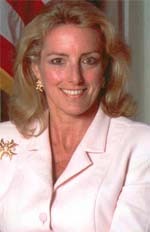Welcome to the October 2009 issue of the Global Washington newsletter. If you would like to contact us directly, please email us.
IN THIS ISSUE
- Note from our Executive Director
- Spotlight: Ambassador Bagley to Speak at Global Washington Annual Conference
- Featured Organization: Woodland Park Zoo
- Changemaker: Greg Tuke – Can people make fundamental change without ever being in the same room?
- Global Entertainment: Half the Sky: Turning Oppression Into Opportunity for Women Worldwide
- Announcements: PATH Accepts Hilton Award, RDI Opens Center for Women’s Land Rights, U.S. House Committee Invites You to Join the Conversation
- Global Washington Upcoming Events
- Other Upcoming Events
Note from our Executive Director
Global Washington’s conference is just seven weeks away! We are excited and working hard to shape the strategy and agenda of the conference to make sure that is very useful to all of you. We would like to capture the challenges that you face everyday in doing development work here in Washington State. Our goal is to have useful conversations that can result in tools and solutions for all of us to take back to our work. We also believe that these tools will assist us to work more closely with one another as a sector to bring about a unified voice for the global development community.
Last week I had an opportunity to hear Nick Kristof At Town Hall here in Seattle. His stories were interesting, and his call to action towards movement building was inspiring. Kristof appeared on Oprah just a few days before coming to Seattle and his call to action led to $3.5 million raised in one week for global women’s issues. In his talks he repeatedly connects the security of the United States to the commitment to increase the well-being of women and girls in the developing world. His book is already in its third printing and Kristof is receiving wide coverage for Half the Sky, his words and his commitment to building a movement for change.
We have already started working with Nick Kriostof to be able to leverage his return to Seattle on Dec 7th as a call to build a movement here in Washington state. We are committed to increase the visibility of global development organizations and the leadership of Washington State in this sector. Please join us on Dec 7th and be a part of this exciting new movement in Washington.
In unity,
Bookda Gheisar, Executive Director
Spotlight: Ambassador Bagley to Speak at Global Washington Annual Conference
We are excited to announce the newest confirmed speaker at this year’s annual conference, Ambassador Elizabeth Frawley Bagley. Ambassador Bagley was appointed by Secretary of State Hillary Clinton to lead the Global Partnership Initiative as the Special Representative for Global Partnerships. At her swearing-in ceremony earlier this year, Ambassador Bagley set out her emphasis on partnerships, saying
“We must now make the transition to 21st Century Statecraft, engaging with all the elements of our national power – and leveraging all forms of our strength. That is where partnerships come in. Our private sector is an extraordinary source of innovation, talent, resources, and knowledge; and in the past, we have only scratched the surface.”
Ambassador Bagley stated that through the Global Partnership Initiative, “we are making the Secretary of State’s emphasis on opening our doors to the private sector a rallying cry for change and a platform for smart power.” We are honored to welcome her and to learn about developing cross-sector relationships to further our global development work.
This dynamic conference is marked by an innovative social media approach to give all community members an equal voice in setting the priorities for our sector. The conference will also feature breakout sessions, panels and speakers on a range of topics including women in poverty, education, health and much more. Click here to view the details and to register now!
Featured Organization: Woodland Park Zoo
 Is global development the first thing that pops into your mind when Woodland Park Zoo comes up? No? Well then, it may be time to take yourself down to the zoo again, with or without the accompaniment of children. When you do, you’ll find that the exhibits not only display exotic animals and educate visitors about the environmental and man-made dangers to their natural habitats, but also engage those same visitors in actions they can take to help local people protect the animals and themselves.
Is global development the first thing that pops into your mind when Woodland Park Zoo comes up? No? Well then, it may be time to take yourself down to the zoo again, with or without the accompaniment of children. When you do, you’ll find that the exhibits not only display exotic animals and educate visitors about the environmental and man-made dangers to their natural habitats, but also engage those same visitors in actions they can take to help local people protect the animals and themselves.
Just take the African Savanna exhibit for example. It showcases the huge varieties of animals, predators including lions and African wild dogs and large herbivores including giraffes, hippos, Grant’s gazelles, fringe-eared oryx, ostriches, zebras and patas monkeys, that inhabit the wild grasslands of East Africa. But the exhibit also focuses on the reasons those habitats are endangered–excessive vegetation growth in the waterholes, human/wildlife conflict over shared wildlife corridors, long fences erected in wildlife corridors. As part of its exhibit, the zoo supports and publicizes the work of the Waterhole Restoration Project in Kenya, which is restoring 18 natural waterholes for the benefit of wildlife in Merrueshi Group Ranch, a wildlife corridor between Chulu and Amboseli National Parks. The founder of the Maasai Foundation, which administers the restoration work, is a cultural interpreter at the zoo during the summer. He educates visitors about his culture, their links to savanna wildlife and how they can help preserve it. Built on the edge of the Savanna exhibit, a reproduction of a modern rural village of East Africa shows visitors how people live who interact with the wildlife around them. There young visitors get the opportunity to make an African beading project to help provide funding for the Waterhole Restoration Project.
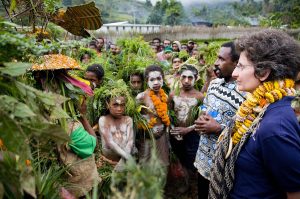 Such projects help children become connected to the world. Interest in wildlife or international development can begin from a spark at the zoo. Once interested, visitors are directed by the zoo to organizations that are providing tangible outcomes. This focus on local community involvement in solutions is critical to the zoo’s mission. Dr. Deborah Jensen, the President and CEO of Woodland Park Zoo, says, “We face common problems whether in U.S or Africa. Solutions require thoughtful local leadership. When we decided, for example, we needed to clean up Puget Sound, we needed local people to lead the way, but we also learned that, as a community, we needed to change the way we operate, the fertilizers we used, the things we threw away. The same is true abroad. We tell our more than one million guests a year how they can help local groups abroad get involved. It is a message of hope, that there are real solutions to difficult community and conservation problems.”
Such projects help children become connected to the world. Interest in wildlife or international development can begin from a spark at the zoo. Once interested, visitors are directed by the zoo to organizations that are providing tangible outcomes. This focus on local community involvement in solutions is critical to the zoo’s mission. Dr. Deborah Jensen, the President and CEO of Woodland Park Zoo, says, “We face common problems whether in U.S or Africa. Solutions require thoughtful local leadership. When we decided, for example, we needed to clean up Puget Sound, we needed local people to lead the way, but we also learned that, as a community, we needed to change the way we operate, the fertilizers we used, the things we threw away. The same is true abroad. We tell our more than one million guests a year how they can help local groups abroad get involved. It is a message of hope, that there are real solutions to difficult community and conservation problems.”
In some ways this is not really a new development. The zoo’s very first veterinarian, Dr. Jim Foster, helped establish the first Mt. Gorilla Research Institute in central Africa and participated in the recruiting and hiring of its first scientist, Dian Fossey. The zoo’s Partners for Wildlife focuses on ways to ameliorate the disappearing habitat of animals caused by human encroachment. These projects work on species preservation, habitat protection, local capacity building and community livelihood. Years ago, Dr. Lisa Dabek, now director of field conservation at Woodland Park Zoo, set the example, founding the Tree Kangaroo Conservation Program in  Papua, New Guinea. After her Ph.D. research on the tree kangaroo at the zoo, Lisa went to Papua New Guinea, and got to know the community there, building a long-term relationship with them. Over the years she talked to people about the long term future of indigenous animals, which were decreasing in numbers. One day she asked a hunter if he thought more tree kangaroos would survive if a part of the land were set aside for them where they could raise their babies and be protected. He later said, “That message struck me like an arrow to my heart.” That insight was the impetus to start the YUS community in a project of community mapping that resulted in their setting aside areas of the land for the tree kangaroos. This year the government of Papua New Guinea turned those same areas into the nation’s first designated Conservation Area. The zoo, in turn, is raising $1 million, to be matched by Conservation International to help create a stream of income for the YUS CO, a local non profit made up of representatives from the conservation area which manages it with TKCP. Deborah Jensen calls this project, “The best example of how citizens around the world can act as a community to help save creatures as well as help the people who live there sustain themselves and the animals.”
Papua, New Guinea. After her Ph.D. research on the tree kangaroo at the zoo, Lisa went to Papua New Guinea, and got to know the community there, building a long-term relationship with them. Over the years she talked to people about the long term future of indigenous animals, which were decreasing in numbers. One day she asked a hunter if he thought more tree kangaroos would survive if a part of the land were set aside for them where they could raise their babies and be protected. He later said, “That message struck me like an arrow to my heart.” That insight was the impetus to start the YUS community in a project of community mapping that resulted in their setting aside areas of the land for the tree kangaroos. This year the government of Papua New Guinea turned those same areas into the nation’s first designated Conservation Area. The zoo, in turn, is raising $1 million, to be matched by Conservation International to help create a stream of income for the YUS CO, a local non profit made up of representatives from the conservation area which manages it with TKCP. Deborah Jensen calls this project, “The best example of how citizens around the world can act as a community to help save creatures as well as help the people who live there sustain themselves and the animals.”
The Botswana Wild Dog Research Project, initially supported by the zoo and later funded by Paul G. Allen Foundation, is currently doing research on the use of scent markers to maintain a natural separation–a kind of bio-fence– between the wild dogs and domestic livestock. Another partner supported by the zoo is the Tarangire Elephant Project in Tanzania working to ensure the viability of the elephant’s ecosystem by initiating agreements with key villages to set aside easements over thousands of acres of land in the Simanjiro plains, the main calving ground for the large elephants. A long research project on the impact of poaching the female leader of the elephant packs is underway as well.
 The zoo contributes money and lends expertise to the Seattle-based Snow Leopard Trust for a long-term study in Mongolia; the trust was founded by a former staffer from the zoo. As part of the trust’s education program local people are asked to pledge not to shoot the snow leopards and in return, the trust helps them make products to sell. The trust conducts workshops with local women and artisans. The zoo recently sent the director of its retail operations to Mongolia to provide advice about what kinds of products could be made that would sell here. He has also helped place their products in other zoos. Every year the zoo helps the trust put on a fundraising event held at the zoo.
The zoo contributes money and lends expertise to the Seattle-based Snow Leopard Trust for a long-term study in Mongolia; the trust was founded by a former staffer from the zoo. As part of the trust’s education program local people are asked to pledge not to shoot the snow leopards and in return, the trust helps them make products to sell. The trust conducts workshops with local women and artisans. The zoo recently sent the director of its retail operations to Mongolia to provide advice about what kinds of products could be made that would sell here. He has also helped place their products in other zoos. Every year the zoo helps the trust put on a fundraising event held at the zoo.
The zoos and aquariums accredited by the Association of Zoos & Aquariums, collectively, devote over $70 million a year to international wildlife conservation. Under President and CEO Jensen and the current board, the Woodland Park Zoo currently partners with 38 field projects in more than 50 countries locally and globally, receiving a third of its funding by private philanthropic donations, with conservation the fastest growing part of the zoo’s budget. Because of the zoo’s emphasis on taking action, this summer alone over 28,000 people heeded the zoo’s call and took part in programs to help conserve the world’s habitats for both animals and humans. The zoo’s message that the solutions are in our hands is taking hold and spreading, locally and globally.
Photo credits: Snow Leopard Cubs – Dennis Dow, Papua New Guinea Celebration (2 photos) – Ryan Hawk/Woodland Park Zoo
Changemaker: Greg Tuke – Can people make fundamental change without ever being in the same room?
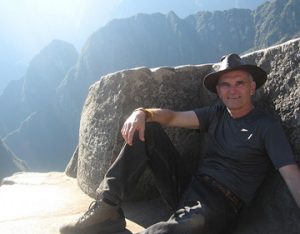 In Kurdish Iraq, they surveyed badly damaged schools, produced a photo project of them and secured a meeting with local officials to convince them of the need for help. In another town another group discovered that a local village’s river was running dry, determined that the cause was an Iranian dam upstream and met with local authorities to convince Iran to release more water or, alternatively, to build an alternative dam to store more water when the river is running.
In Kurdish Iraq, they surveyed badly damaged schools, produced a photo project of them and secured a meeting with local officials to convince them of the need for help. In another town another group discovered that a local village’s river was running dry, determined that the cause was an Iranian dam upstream and met with local authorities to convince Iran to release more water or, alternatively, to build an alternative dam to store more water when the river is running.
In Gaza, they produced a 15 minute video interviewing members of the community about how they felt the world had responded to the recent war in Gaza.
They are from Lebanon, Jordan, Palestine Territories, Iraq, U.S., UK, and in the coming year, Pakistan, Indonesia, and Qatar.
They talk to each other across borders in issue-specific chat rooms over the internet. They are learning how to tell their stories to each other and the world, learning that shouting doesn’t make people listen, learning to understand why others think the way they do. And they are learning that people will listen to them.
Their leadership and media skills were recently featured in CNN, Al Jazeera and VOA.
“They” are high school and college students recruited principally from conflict areas by Global Citizens Corps, a program of Mercy Corps. Through Global Citizens Corps, Greg Tuke is confronting his newest and most profound challenge: harnessing technology to empower youth to address hunger, conflict, health issues, climate change and access to education in their communities. Greg is convinced that Global Citizen Corps is beginning to get to ‘yes’ on the question that technology poses for organizing: “Can people create compelling human relationships that permanently alter the way they see others, themselves and the world, without ever being in the same room?”
 Global Citizen Corps helps over 5,000 young people each year gain leadership skills to mobilize their peers in their schools and communities around global issues. Taking advantage of the internet cafés available in almost any town that has electricity, the program recruits young people who are referred by their teachers or who apply directly online. If selected, they participate in a one year leadership program where they are exposed to summits, workshops as well as online training through podcasts, blogs, and video conferences. The training is three-fold:
Global Citizen Corps helps over 5,000 young people each year gain leadership skills to mobilize their peers in their schools and communities around global issues. Taking advantage of the internet cafés available in almost any town that has electricity, the program recruits young people who are referred by their teachers or who apply directly online. If selected, they participate in a one year leadership program where they are exposed to summits, workshops as well as online training through podcasts, blogs, and video conferences. The training is three-fold:
· Skill development in action planning, fundraising, creating advocacy campaigns, messaging and digital storytelling
· In-depth learning about the root causes of poverty, hunger, climate change, conflict and access to education
· Engagement in cross-cultural dialogue in internet chat rooms with participants from eight countries and participation in a series of video exchanges and conferences with youth in the US, Scotland, Gaza and Iraq
Greg started organizing long before the existence of the technology he now touts, but each step along the way taught him something he is using today. More than 30 years ago the City of Everett inexplicably hired Greg, (well I’m guessing it was probably required for block grant eligibility) to organize Citizen Action Program participants. He soon recognized the constraints the funder can have on an organization’s goals, so he and the residents set up an independent organization called Council for Greater Everett which organized residents around neighborhood issues, housing, abandoned buildings, transportation and utility rate issues. After three years, he moved to Seattle, where he spent the next four years as the first Executive Director of A Territory Resource, a non profit of progressive donors that grants funds to progressive groups engaged in organizing for social change. There he learned fund raising but also a lot about the many issues that progressive groups were addressing in Washington.
One of those issues took him to Group Health: Hanford, and restarting the Nuclear Reactor at Hanford. In those days Group Health’s philosophy was that conflict keeps an organization healthy and so it deliberately hired organizers to work on health issues of importance to its members. But eventually, Group Health’s interest in expanding to the Tri-Cities got the better of its social consciousness so Greg was off looking for a job again, reminded again that the funder’s mission needs to fit the beneficiaries’ goals. He landed at the WaMu Foundation, where his former stereotypes about working in the corporate world were quickly challenged by some very progressive people working on housing and education reform. There he learned about investment, organization, and about how hard it can be to implement change. The leash chafing, his work on education reform took him next to start Powerful Schools, a sort of super PTA for south end Seattle elementary schools, that gave a voice to community groups, parents, teachers and students. There he stayed for eleven years, honing his skills in helping young people change the way they see themselves, the first step in successfully organizing for change.
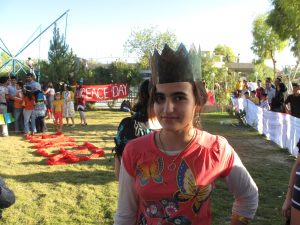 By 1998 he wanted to transfer his experience abroad. Technology was just beginning to provide opportunities no organizer had ever had. He spent time in Guatemala going from one community that had electricity and a computer and to the next community that had electricity and a computer talking to community members about what they needed to improve their lives. A group of individuals funded him for a year while he worked out his ideas about how technology could help. Finally, he worked for three years as Executive Director with Bridges to Understanding, an organization that uses digital technology and the art of storytelling to enhance cross-cultural understanding and help individuals appreciate the value of their own cultures, the last of many steps that lead to his becoming Program Director at Mercy Corps with Global Citizens Corps. By having this youth leadership and action strategy embedded inside an international development organization that works across more than 40 countries, he believes the program has the potential to have a very significant impact world-wide.
By 1998 he wanted to transfer his experience abroad. Technology was just beginning to provide opportunities no organizer had ever had. He spent time in Guatemala going from one community that had electricity and a computer and to the next community that had electricity and a computer talking to community members about what they needed to improve their lives. A group of individuals funded him for a year while he worked out his ideas about how technology could help. Finally, he worked for three years as Executive Director with Bridges to Understanding, an organization that uses digital technology and the art of storytelling to enhance cross-cultural understanding and help individuals appreciate the value of their own cultures, the last of many steps that lead to his becoming Program Director at Mercy Corps with Global Citizens Corps. By having this youth leadership and action strategy embedded inside an international development organization that works across more than 40 countries, he believes the program has the potential to have a very significant impact world-wide.
In 1999, Greg was chosen as one of 25 fellows for the Denali Initiative, a national program for developing promising social entrepreneurs. This three year program focused on helping mid-career leaders in the social sector to bring to scale promising non-profit initiatives. That knowledge should be useful for a program on its way to putting millions of people in touch with each other to help them see themselves in a different light.
Global Entertainment: Half the Sky – Turning Oppression into Opportunity for Women Worldwide
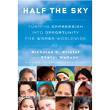 Half the Sky: Turning Opprsesion into Opportunity for Women Worldwide by Nicholas Kristof and Sheryll Wudunn
Half the Sky: Turning Opprsesion into Opportunity for Women Worldwide by Nicholas Kristof and Sheryll Wudunn
Nicholas Kristof and Sheryl Wudunn’s Half the Sky: Turning Oppression into Opportunity for Women Worldwide is an important new book that is both creating waves around the international development community and spurring ordinary citizens to action. In it, Kristof and Wudunn make a compelling case that the paramount human rights problem of this century is the struggle for gender equality in the developing world. They call for the creation of an international movement to emancipate women and girls much like the abolitionist movement of the 1700s and 1800s, wherein governments, individuals, media, and organizations increasingly worked together to eradicate slavery around the world.
Half the Sky addresses three interconnected trends facing women in the developing world: sex trafficking and forced prostitution, gender-based violence, and maternal mortality. The book pulls together years of research and activism. It provides powerful storytelling about women and girls who have been victims of these trends, and about individuals and organizations who have successfully (and unsuccessfully) helped them. The book blends these stories with sometimes overwhelming statistics and hard-hitting analysis, addressing the underlying cultural, educational, and economic factors that lead to these practices.
Much to their credit, Kristof and Wudunn move beyond this causal analysis to address how such oppressive practices have been overcome in specific cases around the world. They give numerous examples of how international NGOs and visionary individuals have fought back by providing women with education, access to heath care and microcredit. They also argue that the actions of the United States and the use of international pressure is a significant factor in overcoming these trends, sighting several instances where pressure from the U.S. caused other governments to crack down on human trafficking or violence against women.
The book does not promote a cookie-cutter approach to solving the issues, but rather suggests that a combination of these approaches, done in a culturally relevant way, is proving effective time and time again. On the other hand, the book does suggest that even culturally ingrained practices that oppress women can be undone as women become empowered to contribute to their family, economy, and community. Kristof and Wudunn argue, if we can just unleash the “girl effect” around the world as has been done in China (the introduction of women into the Chinese economy as a new army of workers has arguably fueled China’s rapid economic development), then their social value will be recognized, their status increased, and their self worth will benefit.
One last feature of the book worth noting is this: it provides the reader with suggestions for concrete actions you can take to help, and with an appendix of organizations who are working on these issues. Thus Kristof and Wudunn provide us with an outline of the problem, some suggested solutions, and the next steps that we as readers can take to participate in this important movement for gender equality.
Reading this book is not for the faint of heart, as it contains graphic narrative about violence, heartbreaking neglect, abuse, and systematic oppression. But I highly recommend that you read it. The book provides a much-needed frame that connects several issues, and makes suggestions about how these issues should be addressed—it may just inspire a newly revitalized, and more coordinated effort to end gender-based oppression and empower women around the world.
Ketty Loeb, Wokai
Announcements
- RDI Launches the Global Center for Women’s Land Rights: On October 15, the International Day for Rural Women, the Rural Development Institute (RDI) launched the Global Center for Women’s Land Rights. Through this initiative, RDI will create a platform to advocate for laws that provide secure property rights for women and girls and raise awareness about women’s role at the strategic center of poverty reduction and food security. Learn more about the center here. RDI was also recognized this month by Forbes Magazine in a story profiling their work in India, ‘Microland’ For The Poor: An old idea for combating poverty gets a new lift.
- PATH Recognized with the Conrad N. Hilton Award: PATH President and CEO Chris Elias accepted the Conrad N. Hilton Humanitarian Prize for 2009, the world’s largest humanitarian award, and delivered a speech on behalf of PATH at a gala luncheon in Washington, D.C. on September 21st. Nobel Peace Prize Laureate, Muhammad Yunus, delivered the key note address at this event. The award is presented annually to a nonprofit organization judged to have made exemplary and extraordinary contributions toward alleviating human suffering. The recognition comes with a coveted $1.5 million award, which will be directed to the Catalyst Fund, and used for expanding our work around the world and addressing new areas of need. For more information click here.
- U.S. House Committee on Foreign Affairs Invites You to Join the Conversation: Foreign assistance is a critical component of America’s national security strategy and an essential tool to respond to long-term development and security challenges as well as urgent humanitarian needs. The Chair of the House Committee on Foreign Affairs, Rep. Howard Berman, is asking for suggestions on fundamental reform of US aid policy. They can be submitted online at the Committee’s website.
Global Washington Upcoming Events
- October 29th: New Innovations & Technology for Fundraising: Mobile Giving
- November 18th: Global Social – South America
- December 7th: GLOBAL WASHINGTON CONFERENCE: A Blueprint for Action – register now!
Other Upcoming Events
Click here to see a full list of international development events on the Global Washington’s calendar. Upcoming events include:
- October 24: Benefit for All As One
- October 24: United Nations Day Public Forum: Food Security and Climate Change
- October 26: A Conversation with Ban Ki-Moon, Secretary-General of the United Nations
- October 26: Irene Khan: Solving Global Poverty
- November 1: Dia de los Muertos Fundraising Fiesta for WaterForHumans.Org
- November 10: PeaceTrees Vietnam’s 14th Anniversary Luncheon
- November 14: 11th Annual Africa Day Business Forum
- November 15: Water Quality Technology Conference
Please submit your events to our calendar!

